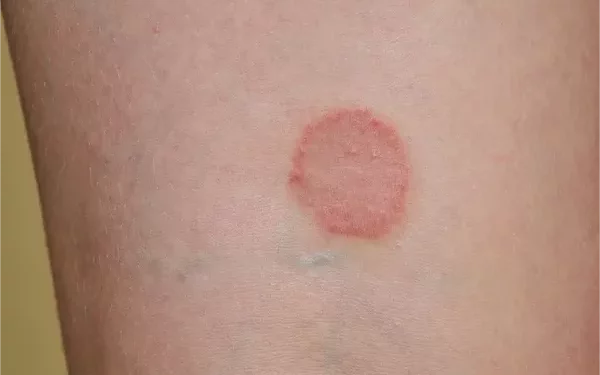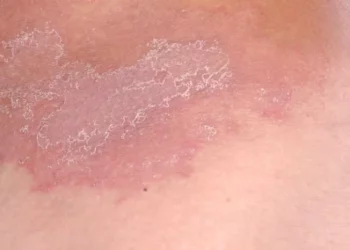Ringworm, despite its name, is not caused by a worm but by a group of fungi known as dermatophytes. These fungi live on the dead tissues of the skin, hair, and nails. The infection can occur in humans and animals, presenting itself as a red, itchy, circular rash with clearer skin in the middle. Understanding what causes ringworm and how to treat it is crucial for effective management and prevention of this common fungal infection.
Causes of Ringworm
Ringworm is primarily caused by dermatophytes, which are a type of fungus that thrives on keratin, a protein found in skin, hair, and nails. There are several species of dermatophytes, but the most common ones causing ringworm in humans include Trichophyton, Microsporum, and Epidermophyton.
1. Human-to-Human Contact: Ringworm is highly contagious and can spread through direct skin-to-skin contact with an infected person. This is common in settings like schools, gyms, and other places where people are in close physical proximity.
2. Animal-to-Human Contact: Pets such as dogs and cats, and farm animals like cows, goats, and horses, can carry the fungi and transmit ringworm to humans. Children are particularly susceptible due to their close contact with pets.
3. Object-to-Human Contact: The fungi causing ringworm can linger on objects such as clothing, towels, bedding, and combs. Sharing these items with an infected person can lead to the spread of the infection.
4. Soil-to-Human Contact: Although less common, ringworm can also spread from contact with infected soil. This typically requires prolonged exposure, as dermatophytes do not survive well in soil.
Symptoms of Ringworm
Recognizing the symptoms of ringworm is the first step in seeking appropriate treatment. The appearance of ringworm can vary depending on its location on the body:
1. Tinea Corporis (Body Ringworm): Characterized by a red, circular, flat sore that may be accompanied by scaly skin. The outer part of the sore may be slightly raised while the skin in the middle appears normal.
2. Tinea Pedis (Athlete’s Foot): Affects the feet, especially between the toes. Symptoms include itching, burning, and cracked, peeling skin.
3. Tinea Cruris (Jock Itch): Occurs in the groin area and is more common in men and adolescent boys. It presents as red, itchy, and ring-like patches.
4. Tinea Capitis (Scalp Ringworm): More common in children, this form affects the scalp, causing scaly, itchy patches of skin and sometimes hair loss.
5. Tinea Unguium (Nail Fungus): Affects the fingernails or toenails, leading to thickened, discolored, and brittle nails.
Diagnosing Ringworm
A healthcare provider can usually diagnose ringworm based on the appearance of the skin. However, to confirm the diagnosis, the following methods may be used:
1. Skin Scraping: A sample of the affected skin is taken and examined under a microscope to look for fungal elements.
2. Culture: A sample from the infected area is cultured to identify the specific type of fungus causing the infection.
3. Wood’s Lamp: This special light can be used to examine the skin. Some types of fungi will fluoresce under the lamp, aiding in diagnosis.
Treating Ringworm
Treatment of ringworm aims to eliminate the fungal infection and alleviate symptoms. The approach to treatment depends on the severity and location of the infection.
1. Topical Antifungal Medications: For mild to moderate ringworm, over-the-counter (OTC) antifungal creams, lotions, or powders are usually effective. Common ingredients in these products include clotrimazole, miconazole, and terbinafine. These should be applied to the affected area as directed, usually for at least two weeks.
2. Prescription Topical Medications: If OTC treatments are not effective, a healthcare provider may prescribe stronger topical antifungal medications.
3. Oral Antifungal Medications: For more severe or widespread infections, or for ringworm affecting the scalp or nails, oral antifungal medications may be necessary. Common oral treatments include terbinafine, itraconazole, and fluconazole. These medications usually need to be taken for several weeks to ensure the infection is fully eradicated.
SEE ALSO: Is Ringworm Contagious Before Symptoms Appear?
4. Home Remedies and Adjunct Treatments: While antifungal medications are the mainstay of treatment, some home remedies may help alleviate symptoms or support the healing process. These include:
- Tea Tree Oil: Known for its antifungal properties, tea tree oil can be applied topically to the affected area. However, it should be diluted with a carrier oil to avoid skin irritation.
- Apple Cider Vinegar: Applying apple cider vinegar with a cotton ball to the infected area may help due to its antifungal properties.
- Garlic: Garlic has natural antifungal properties and can be crushed and applied to the affected area, although this may cause skin irritation for some people.
Preventing Ringworm
Preventing ringworm involves measures to reduce exposure to the fungi and minimize the risk of spreading the infection. Key prevention strategies include:
1. Maintain Good Hygiene: Regularly wash hands, body, and hair with soap and water, especially after contact with animals, soil, or infected individuals.
2. Keep Skin Dry and Clean: Fungi thrive in warm, moist environments. Ensure skin, especially areas prone to sweating like the groin and feet, is kept dry.
3. Avoid Sharing Personal Items: Do not share clothing, towels, hairbrushes, or other personal items with others, particularly if they are infected.
4. Wear Protective Clothing: In communal areas like gyms or swimming pools, wear flip-flops or sandals to avoid direct contact with potentially contaminated surfaces.
5. Clean and Disinfect: Regularly clean and disinfect objects and surfaces that may be contaminated with the fungi, such as gym equipment, shower stalls, and pet bedding.
6. Take Care of Pets: Ensure pets are regularly checked and treated for ringworm by a veterinarian. Keep infected animals away from communal areas until they are fully treated.
Complications of Untreated Ringworm
While ringworm is generally not serious, if left untreated, it can lead to complications, including:
- Spread of Infection: The infection can spread to other parts of the body or to other people.
- Secondary Bacterial Infections: Scratching the itchy areas can lead to breaks in the skin, which may become infected with bacteria.
- Chronic Infections: In some cases, untreated ringworm can become a persistent or recurrent problem.
When to See a Doctor
It is important to seek medical attention if:
- The infection does not improve after a week of using OTC treatments.
- The infection spreads or worsens despite treatment.
- You have a weakened immune system and develop symptoms of ringworm.
- The infection affects the scalp or nails, as these may require prescription treatments.
Conclusion
Ringworm is a common fungal infection that can affect various parts of the body. Understanding its causes, symptoms, and treatment options is crucial for effective management and prevention. By maintaining good hygiene, avoiding shared personal items, and seeking timely treatment, you can effectively manage and prevent ringworm infections. If you suspect you have ringworm or if the infection does not respond to initial treatments, consult a healthcare provider for further evaluation and management.
Related Topics:



























